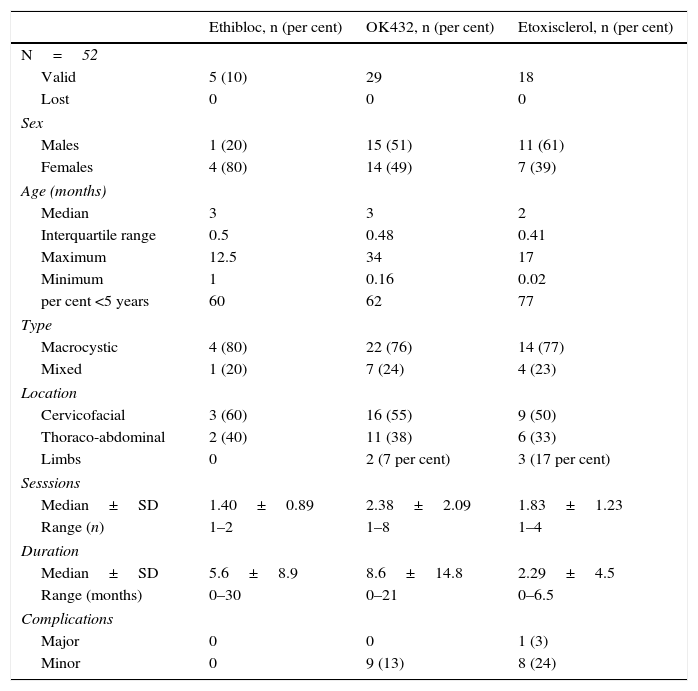Analyze statistically the success, number of sessions required and complete duration of treatment of agents used in pediatric percutaneous sclerotherapy of lymphatic malformations, to determine the most suitable.
Material and methodsRetrospective study based on outcomes from percutaneous sclerotherapy performed on lymphatic malformations of 56 patients conducted by pediatric interventional radiologist for 14 years. As first approach, the procedure consists of ultrasound-guided introduction of sclerosing agent. Sessions were repeated until clinical resolution. Success, number of sessions and the duration of treatment were recorded and statistical treatment of the data was performed to obtain further conclusions.
ResultsLost patients in follow up and other minority agents used were excluded from the data. Eventually, 52 patients treated with OK432 (n=29), Ethibloc (n=5) and combination therapy (n=18) were included. The average number of sessions and duration in months of treatment was respectively 2.38 and 8.6 for OK432, 1.4 and 5.6 for Ethibloc, and 1.83 and 2.30 for dual therapy. The results were statistically significant for the difference in duration between OK432 and dual therapy. Also, 60–80 per cent of patients reached proper results related to success, but the difference was no significant among the agents. Other demographic and anatomical variables were analyzed, not showing any difference, which supports the homogeneity of the sample.
ConclusionsDespite of no significant difference in success and number of sessions among agents, longer duration of treatment with OK432 than dual therapy could mean greater health costs and probably greater disturb for patient and family.
Estudio estadístico del éxito, el número de sesiones necesarias y la duración global del tratamiento percutáneo con esclerosantes de malformaciones linfáticas pediátricas que oriente la elección del esclerosante.
Material y métodosEstudio retrospectivo basado en los resultados obtenidos durante 14 años por Radiología Intervencionista Pediátrica en el tratamiento percutáneo de malformaciones linfáticas macroquísticas realizado en 56 pacientes. El procedimiento consiste en introducir el esclerosante bajo control ecográfico como único tratamiento, repitiendo las sesiones en ausencia de respuesta o sintomatología persistente hasta el alta. Se realiza un análisis descriptivo y estadístico del éxito, el número de sesiones y la duración del tratamiento para la obtención de conclusiones.
ResultadosSe excluyen los pacientes perdidos en el seguimiento y los tratados con agentes concretos, con un número final de 52 pacientes tratados con OK432 (n=29), Ethibloc (n=5) y terapia combinada (n=18). El promedio de las sesiones y la duración (meses) del tratamiento fueron, respectivamente, de 2,38 sesiones y 8,6 meses para OK432, 1,4 sesiones y 5,6 meses para Ethibloc, y 1,83 sesiones y 2,30 meses para la terapia dual. Los resultados fueron estadísticamente significativos en la diferencia de la duración del tratamiento entre OK432 y la terapia dual. No hubo diferencias en el éxito ni en el número de sesiones, al igual que entre otras variables demográficas y anatómicas, en favor de la homogeneidad de la muestra.
ConclusionesLas diferencias entre un tratamiento más prolongado con OK432 frente a la terapia dual podrían suponer un mayor gasto sanitario y más frecuentación hospitalaria, con un mayor inconveniente para familiares y pacientes.
Artículo
Comprando el artículo el PDF del mismo podrá ser descargado
Precio 19,34 €
Comprar ahora















